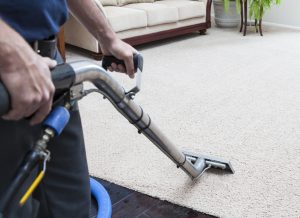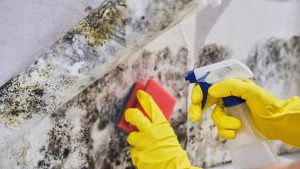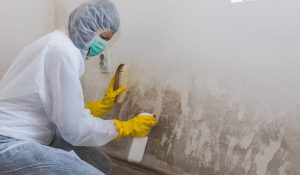
Mould can silently compromise structural integrity and indoor air quality in Sydney residences, posing serious health and financial risks if left unchecked. Recognising this threat, homeowners need clear guidance on assessing mould hazards, understanding the causes linked to flood water damage, and choosing expert mould remediation & removal services that restore safety and prevent recurrence. In this article, we will explore:
- What mould is and why it threatens Sydney homes
- The health impacts of mould exposure for residents
- The link between flood water damage and mould growth
- Why professional remediation outperforms DIY approaches
- Proven prevention strategies to keep mould at bay
- Key criteria for selecting a reliable mould remediation service
By following these insights, Sydney homeowners can safeguard their property investment and protect their family’s well-being with confidence.
What Is Mould and Why Is It a Threat to Sydney Homes?
Mould is a microscopic fungus that thrives in damp environments by breaking down organic materials, releasing spores that compromise indoor air quality and weaken structural surfaces. Understanding this biological process equips homeowners to tackle underlying moisture issues before spore proliferation damages walls, ceilings and furnishings.
Mould not only discolours surfaces but also accelerates timber decay and plaster deterioration, making early detection essential to preserve home value and occupant health.
What Are the Common Types of Mould Found in Sydney Homes?
Below is a comparison of prevalent mould species encountered in Sydney residences, highlighting their appearance and typical locations.
| Mould Species | Appearance | Typical Location |
| Aspergillus | Powdery, green-yellow clusters | HVAC ducts, ceilings |
| Cladosporium | Olive-green or brown spots | Window frames, carpets |
| Penicillium | Blue-green, velvety growth | Wet drywall, insulation |
| Stachybotrys chartarum | Dark black, slimy patches | Water-damaged timber |
Each species thrives under specific moisture conditions and poses distinct risks, guiding targeted remediation methods that restore healthy indoor environments and prevent future colonisation.
How Does Mould Develop in Residential Properties?
Mould develops when humidity or water intrusion meets organic building materials, providing the nutrients and moisture fungi required to germinate and spread within 24–48 hours. Recognising these moisture pathways helps homeowners pinpoint ventilation gaps, plumbing leaks or condensation hotspots that fuel fungal growth.
Why Is Black Mould Particularly Dangerous?
Black mould, or Stachybotrys chartarum, produces mycotoxins that can trigger respiratory symptoms and other health effects when inhaled over prolonged periods. Identifying its characteristic dark slimy patches is critical, as this species often indicates chronic water damage and poses elevated health concerns.
Swift removal of black mould not only eliminates a potential hazard but also prevents secondary infestations that can undermine structural components and worsen air quality.
What Are the Health Risks of Mould Exposure for Sydney Residents?
Inhaling mould spores and mycotoxins can provoke a range of health effects, from mild allergic reactions to respiratory conditions, so understanding these impacts drives prompt remediation and reduces long-term complications.
Health Risks of Mould Exposure
Exposure to mould spores can trigger a range of health issues, from allergic reactions to respiratory problems. These reactions are caused by the body’s immune response to airborne fungal allergens, highlighting the importance of effective mould remediation to maintain indoor air quality and protect respiratory health.
Centers for Disease Control and Prevention (CDC), “Mould” (2024)
This source provides information on the health effects of mould exposure, which supports the article’s discussion of health risks.
Which Respiratory and Allergic Symptoms Are Caused by Mould?
- Chronic coughing and wheezing that mimic asthma attacks
- Nasal congestion with runny nose and sinus irritation
- Red, itchy eyes and persistent throat soreness
Who Is Most Vulnerable to Mould-Related Health Issues?
- Children with developing respiratory systems
- Elderly residents with diminished immune defences
- Asthma sufferers prone to exacerbated breathing distress
How Does the NSW Health Guide Mould-Related Health Precautions?
NSW Health issues evidence-based guidelines for mould management, advising residents to maintain indoor relative humidity below 60%, repair leaks promptly and dry wet areas within 24–48 hours of water damage. These precautions reduce mould proliferation and align with professional remediation standards that protect occupant health.
How Does Flood Water Damage Lead to Mould Growth in Sydney Homes?
Flood water damage saturates building materials and trapping moisture within walls and subfloors creates ideal conditions for mould colonisation. By understanding this cause-and-effect relationship, homeowners can prioritise rapid water extraction and structural drying to prevent extensive fungal invasion.
What Are the Common Flood-Related Causes of Mould Infestation?
- Seepage through cracked foundations leading to rising damp
- Leaking pipes and burst fittings hidden behind walls
- Poorly dried carpets and flooring after water intrusion
Why Is Immediate Flood Water Removal Critical to Prevent Mould?
Immediate flood water removal stops moisture penetration and halts spore germination at an early stage, preventing deep-seated fungal growth and structural deterioration. Quick action reduces remediation costs and protects timber, plaster and drywall from irreversible damage.
How Does Flood Squad Address Flood Damage and Mould Remediation Together?
Flood Squad integrates rapid water extraction with full-scale mould remediation to restore Sydney homes to safe, habitable conditions. Their coordinated process includes:
- Emergency water removal to eliminate standing moisture
- Drying and dehumidification to reach safe moisture levels
- Comprehensive mould inspection to locate hidden colonies
- Targeted remediation using industry-approved biocides
- Clearance testing to confirm spore levels are within safe limits
This unified approach ensures that flood water damage and mould growth are tackled concurrently, preventing re-infestation and restoring confidence in a healthy living space.
Why Is Professional Mould Remediation Essential Compared to DIY Methods?
Professional mould remediation uses certified procedures and specialised equipment to eradicate fungal colonies at the source and establish barriers against future growth, delivering long-term protection that DIY methods cannot guarantee.
What Are the Limitations of DIY Mould Removal?
- Inadequate containment that spreads spores to unaffected areas
- Ineffective cleaning methods that leave root structures intact
- Health hazards from improper use of pesticides and biocides
What Are the Key Steps in a Professional Mould Remediation Process?
A certified remediation process follows these structured phases:
- Conduct a detailed mould assessment and moisture mapping
- Establish containment zones to prevent cross-contamination
- Remove mould-infested materials safely and responsibly
- Apply antimicrobial treatments to decontaminate surfaces
- Deploy drying equipment and monitor moisture levels
- Perform clearance tests to verify spore counts are safe
Professional Mould Remediation Process
Professional mould remediation involves a structured process, including assessment, containment, removal of infested materials, antimicrobial treatments, drying, and clearance testing. This comprehensive approach ensures thorough results and reduces the likelihood of mould recurrence, which is essential for long-term protection and improved indoor air quality.
Environmental Protection Agency (EPA), “A Brief Guide to Mold, Moisture, and Your Home” (2023)
This citation supports the article’s explanation of the steps involved in professional mould remediation, emphasising the importance of a systematic approach.
How Do Certified Technicians Ensure Long-Term Mould Prevention?
Certified technicians enhance durability of remediation through:
- Precision moisture mapping to seal off moisture entry points
- Use of industrial-grade dehumidifiers and air scrubbers
- Implementation of mould-resistant coatings and sealants
- Detailed homeowner guidance on humidity control and ventilation
Their expertise in building science and fungal biology supports sustained protection and improved indoor air quality.
What Are Effective Mould Prevention Strategies for Sydney Homes?
Proactive moisture management and regular inspections form the backbone of mould prevention, enabling homeowners to maintain a dry environment that inhibits spore germination and preserves indoor air quality.
How Can Homeowners Control Moisture and Humidity to Prevent Mould?
- Installing extractor fans in bathrooms and kitchens
- Running dehumidifiers during humid weather months
- Sealing leaks around windows, doors and plumbing fittings
- Ensuring adequate airflow through ceiling vents
These controls keep relative humidity below 60%, reducing the risk of mould establishment and safeguarding building materials.
What Immediate Actions Should Be Taken After Water Damage or Flooding?
- Remove standing water promptly with wet-vacuum extraction
- Wipe down and ventilate wet surfaces within 24–48 hours
- Discard soaked porous materials like carpets and insulation
- Document damage for insurance and professional assessment
Swift action halts microbial growth and sets the stage for thorough drying and remediation.
How Does Regular Mould Inspection Help in Early Detection?
Regular professional inspections identify hidden mould behind walls, under floorboards and within ductwork before visible signs emerge. By mapping moisture anomalies and extracting air samples, inspectors can recommend targeted interventions that prevent minor issues from escalating.
Consistent monitoring supports ongoing maintenance and preserves a healthy living environment.
Why Professional Mould Remediation Outperforms DIY Methods
Evaluating certifications, experience and service guarantees ensures selection of a reliable mould remediation provider that delivers safe, lasting results and peace of mind.
Why Are Certifications and Experience Important in Mould Remediation?
Certifications (such as IICRC-accredited credentials) and extensive field experience demonstrate a provider’s adherence to rigorous protocols and familiarity with complex mould scenarios. Technicians with proven track records apply validated methods that minimise health risks and structural damage.
How Does Flood Squad’s Rapid Response Benefit Sydney Residents?
Flood Squad’s rapid response team mobilises within hours of a water or mould emergency, limiting moisture exposure and spore colonisation. Their coordinated water extraction and mould remediation operations accelerate property restoration, reduce downtime and protect household health.
Fast intervention not only prevents extensive damage but also restores normal living conditions sooner.
What Guarantees and Follow-Up Services Should Be Expected?
| Guarantee Type | Coverage Details | Benefit |
| Remediation warranty | Up to 12 months on treated areas | Secures long-term protection |
| Clearance certification | Spore count verification post-treatment | Confirms safe air quality |
| Follow-up inspection | Complimentary check within 3 months | Ensures no re-infestation occurs |
These assurances demonstrate a provider’s commitment to quality and reinforce homeowner confidence in lasting mould control.
Flood Squad’s integrated approach, certified technicians and comprehensive guarantees equip Sydney homeowners with reliable solutions that restore property integrity and indoor air safety. Whether addressing flood-related mould outbreaks or proactively preventing fungal growth, investing in professional remediation ensures a healthier, more resilient home environment.
Ready to protect your Sydney home from mould threats? Reach out to our experts for a prompt inspection, tailored remediation plan and lasting peace of mind. Our team combines rapid response, certified procedures and clear pricing transparency to restore your property’s safety and comfort without delay. Trust Flood Squad to deliver professional mould remediation & removal services that safeguard both your health and investment.Contact us for a free assessment with Flood Squad.



